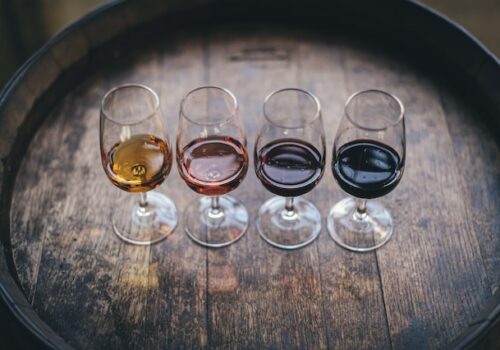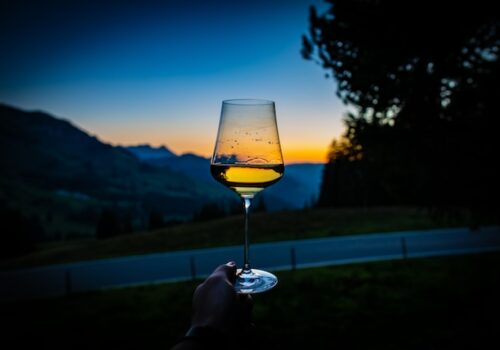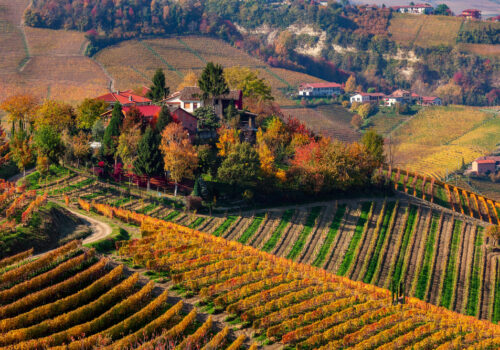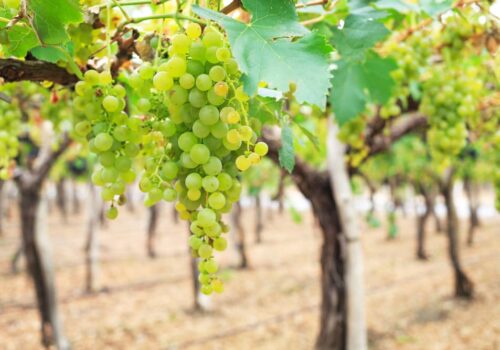The best white varieties for winemaking
Chardonnay
Chardonnay is an internationally known technical variety of Western European origin. It is not possible to find out its pedigree, but it is believed that it is a cross between Pinot Noir and Gué Blanc.
The berries are processed to produce wines with different flavors and fruity aromas. Also part of the harvest is sent annually for the production of wine materials, which are later used as a flavor enhancer of champagne.
Brief characteristics of the plant:
- The bush is formed medium-grown, although strong stems are also found;
- The vegetation period lasts 130-140 days;
- flowers are monoecious, which ensures good pollination;
- conical bunches are loose, weighing 900-1000 gr;
- white-green berries are tinged with a golden hue;
- shape of fruits – rounded slightly elongated;
- Weight of grape – 12-15 grams, each grape contains 2-3 seeds;
- sugar content – 18% with acidity of 8-12 grams per liter;
- Yields – 8-12 t / ha;
- crop is frost-resistant, can withstand temperatures up to minus 20°.
Bianca
The Bianca wine has an unsurpassed taste with notes of vanilla and almond. For the production of table, semi-sweet and other wines, blending with other juices that have low sugar content is used. This helps to avoid the sugary taste that is characteristic of this grape.
The grape was bred in Hungary, and the parents are Villar Blanc and Chasla Bouvier.
Brief characteristics of the plant:
- Early maturing, with a growing season of 110-120 days;
- medium shrub;
- brush cylindrical shape, weight 90-120 g;
- fruits are small and medium, weight 1.5 gr;
- The shape of berries rounded, slightly elongated, color greenish-yellow;
- skin thin, harmonious taste, filled with a bouquet of aromas;
- The harvest does not lose its commercial appearance on the vine after full maturity;
- Sugar content – 20-28% with acidity of 7-9 g / l;
- High resistance to mildew, grey mould, oidium, tolerance to phylloxera;
- frost-resistance – up to minus 27°.
Muscat
Muscat is medium-ripening with a vegetation period of 130-140 days. Muscat is one of the oldest varieties originating from Syria, Arabia and Egypt. The peculiarity of the culture is the ability to accumulate high levels of sugar (up to 25% with an acidity of 6.5-7 g/l).
Brief characteristics:
- The bush is of medium size;
- The weight of conically shaped bunches is 100-450 g;
- berries are dense on the brush, the weight of one on average 4 g;
- flavor is full of nutmeg;
- Yield is 66-109 c / ha;
- resistance to disease is low.
- Excellent marketable and gustatory qualities outweigh poor survival in adverse climatic conditions. Grapes immediately responds to lack of moisture and its overabundance, is not resistant to low temperatures, requires potassium fertilizers.
Sauvignon Blanc
The variety was obtained by crossing Chenin blanc and Taminer. Thanks to magnificent taste and balance of sugar and acidity, the grape has received recognition all over the world. The peculiarity of the culture is the timely harvest. When overripe, the berry loses its properties and taste qualities and becomes unsuitable for winemaking.
Brief characteristic:
- vegetation period 130-135 days;
- bush is medium-grown, but quite powerful with developed root system;
- bunches are small, weighing 75-120 g;
- berries small, color greenish-white with waxy coating (each contains 2-3 seeds);
- yield is low;
- Sugar content – 18-23% with acidity 6,7-11 g / l.
Culture shows weak resistance to oidium and gray rot, tolerance to mildew. Flower shedding is noted in conditions of growing with high humidity. Soils are preferred with the content of clay layers, as well as gravel and sandy inclusions.
Riesling
This variety, a gift of nature itself, is considered the king of the wine industry. High-quality wines are made from berries with an excellent taste, which is full of different notes and shades.
Brief characteristics:
- vegetation period – 140-150 days;
- The bunches are dense, weight 80-100 gr;
- Berries are yellow-green with a glaucous tint, weighing 1.3-1.5 g, rounded;
- skin dense, but thin;
- hardiness to minus 20 °;
- Full ripening of fruits comes in October-November;
- Sugar content 18% with acidity 9-11 g / l;
- resistance to diseases is low.
Pinot Blanc
This representative of the Pinot family is characterized by its multifaceted qualities of taste; it is used to produce still, sparkling and dessert wines. Burgundy is the birthplace of the plant, but today boasts high yields in almost every country in Europe and other regions.
Brief characteristics:
- The growing season is 140-150 days;
- bunches of medium density weighing 85-150 grams;
- Yellow-green round-shaped berries, weighing 1.4-1.7 g;
- average sugar content reaches 20%.
- The peculiarity of the variety lies in its low content of acid and aromatic substances, as a result of which Pinot Blanc is recommended for making wine to be consumed young.




